Founded in 1997, FC Nordsjaelland has become one of the most interesting and exciting teams all over the world, after their achievements to qualify for the UEFA Europa League in 2008 or their first title in the Danish Superliga in 2012 that allowed them to play for the first time in their history, the most prestigious tournament in the continent, the UEFA Champions League, where they faced against teams like Juventus and Chelsea in that season.
Their development and team plan are probably one of the most serious and established in Denmark and around the world. FC Nordsjaelland are the youngest team in the league, averaging 20,7 years of age. They count on the most foreigners with 19 players abroad too, and plenty of opportunities for their young players that come through the academy.
After 12 matches played, the Farum’s football club has ended the first round as leaders of the league, with the irregular starts of big teams in the country like Kobenhavn. They could be on their way to achieving what they haven’t done since 2012, with a great coaching staff and a tactical plan that we are going to assess next.
Let’s take a look at the tactics deployed by Flemming Pedersen. This tactical analysis piece will be a team scout report of Denmark Superliga side FC Nordsjaelland early into the 2022/23 campaign.
Short pressing and a locked mid-block
FC Nordsjaelland possess intense and young players that like to commit to the defensive phase of the team. However, Pedersen’s team have a mature and strict shape when they’re off-the-ball and it has been working game after game, which has taken them top of the league.
When the opponents are building up from the back, they like to press very high for a few seconds, with the fast sprint and energy from players like Ernest Nuamah in the centre-forward spot or Andreas Schjelderup, who has been of interest for Arsenal, and Mads Hansen in the wings, the first one tries to take the goalkeeper, shadowing the ‘6’ behind him, and wingers go for the centre-backs, with other players taking mixed responsibilities on zonal and man-marking roles.
In the example below, we can see them setting up a 4-4-2 where the left-winger has pulled the trigger to press high, as well as Mohamed Diomandé, the attacking midfielder, having joined the defensive shape as a striker. In this occasion, we see automatic movements when Nordsjaelland sits on a mid-block and some of their attackers decide to jump off this block and try to steal the ball in more advanced positions.
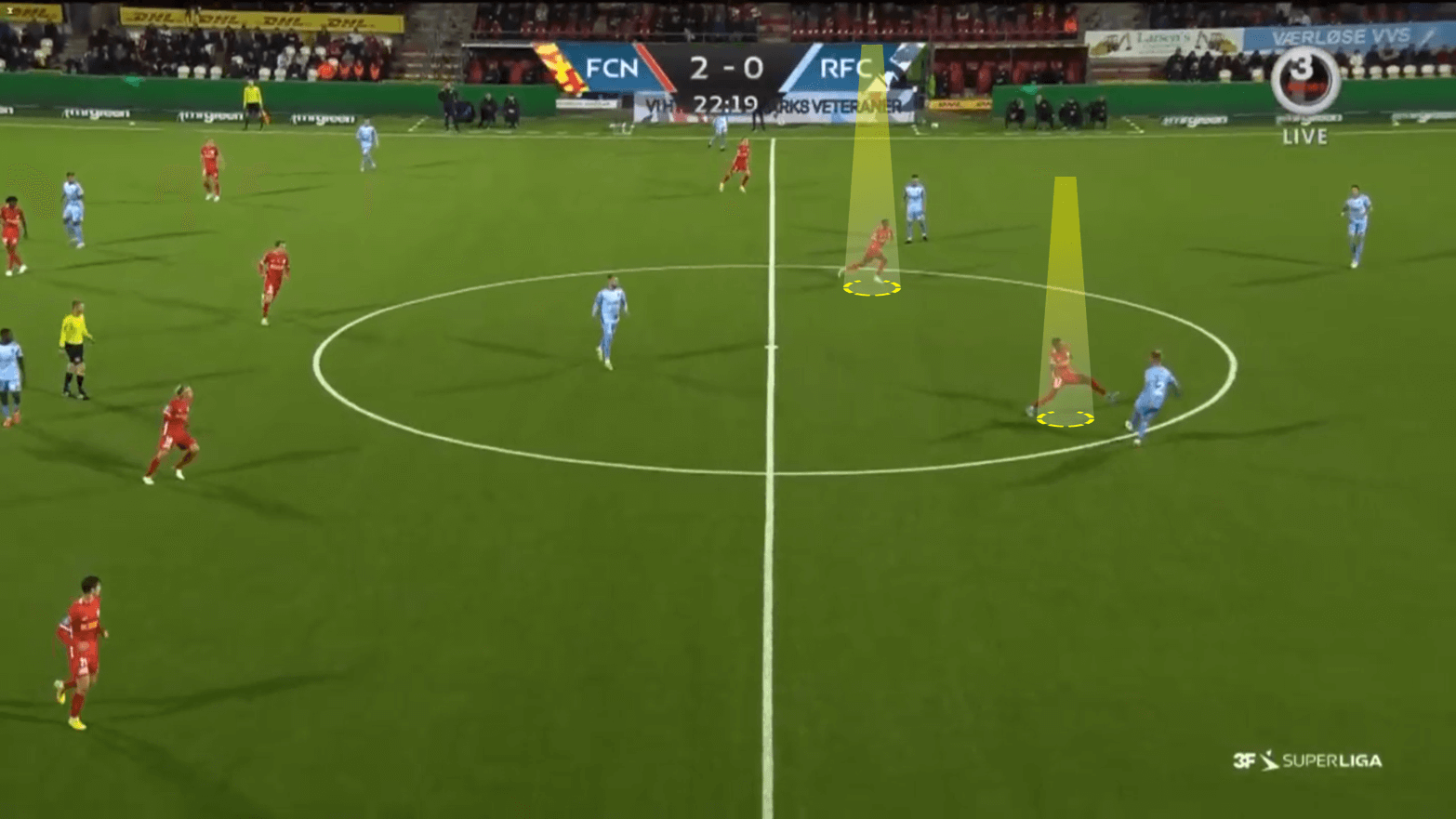
Nevertheless, this doesn’t last for much time, only for 4 or 6 seconds, and if this won’t have success, they track back to set up a solid, rigid and locked mid-block that usually is formed in a 4-3-3 with narrow attackers, or a 4-4-2. They look to overload the central areas and force the rivals to take hasty decisions where they can win the ball back and counterattack with high speed in most of their players. They also look to stress them by leaving them more time with the ball, but blocking all the spaces to possibly break lines, as when they don’t find the pockets to do this, they can take the worst decisions, allowing them to get the ball back.
As we can see in this mid-block moment, the three attackers like to stay more narrow to block passing lanes through the middle, where midfielders behind them overload and lock these central spaces very well. This is the kind of situation that repeats frequently in the defensive part of the Nordsjaelland game plan- Short, high-pressing that lasts in a maximum time of up to 6 seconds, and then the whole squad are tactically smart to track back, recognise their positions and form this tough block.
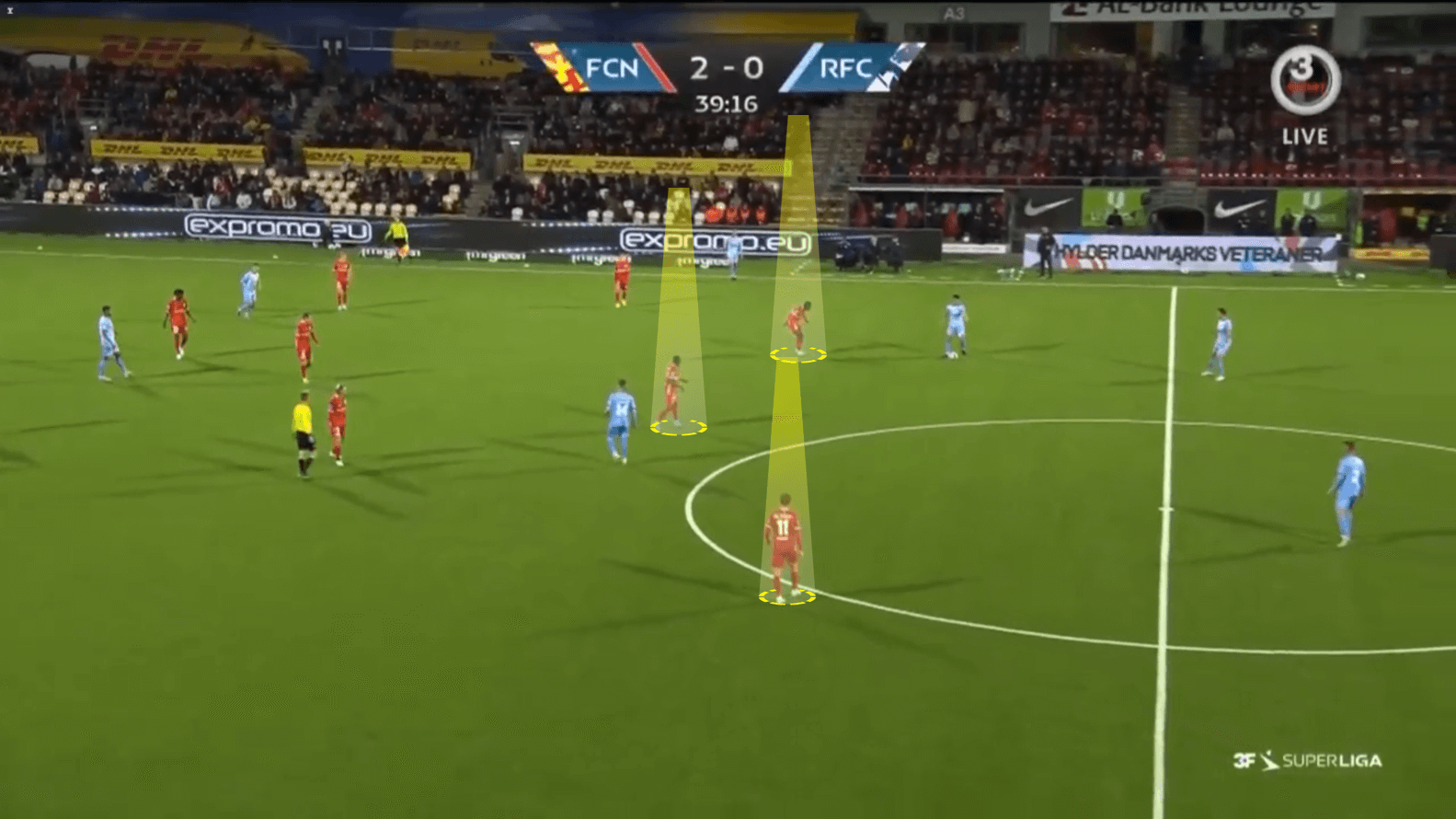
As mentioned, this team has a high level of tactical understanding. Players with 18 or 20 years look like veterans and experienced players when they are forced to play in annoying situations of the match. One of the most worked things Nordsjaelland shows on the pitch is the exchanges between blocks, which they are forced into in several conditions. When the rival team has been able to get forward and push them almost to the penalty box, players track back and make a solid low block with very close lines that don’t allow opponents to appear behind the midfielders.
This example shows exactly what we are talking about. Nordsjaelland was pressing high seconds before they get the ball back in the mid-block and then lose it again. Randers have found a way to break the pressure and step on these advanced areas of the pitch, which they didn’t do it regularly in this match. The attackers stay narrow and the midfielders block passing options behind them. However, a player has appeared free and sees his striker free between the two centre-backs of the team, but the positioning of the midfielders help to confuse the striker on which decision to make, and this gave plenty of time to the left-centre-back (yellow) to go out and cut the pass.
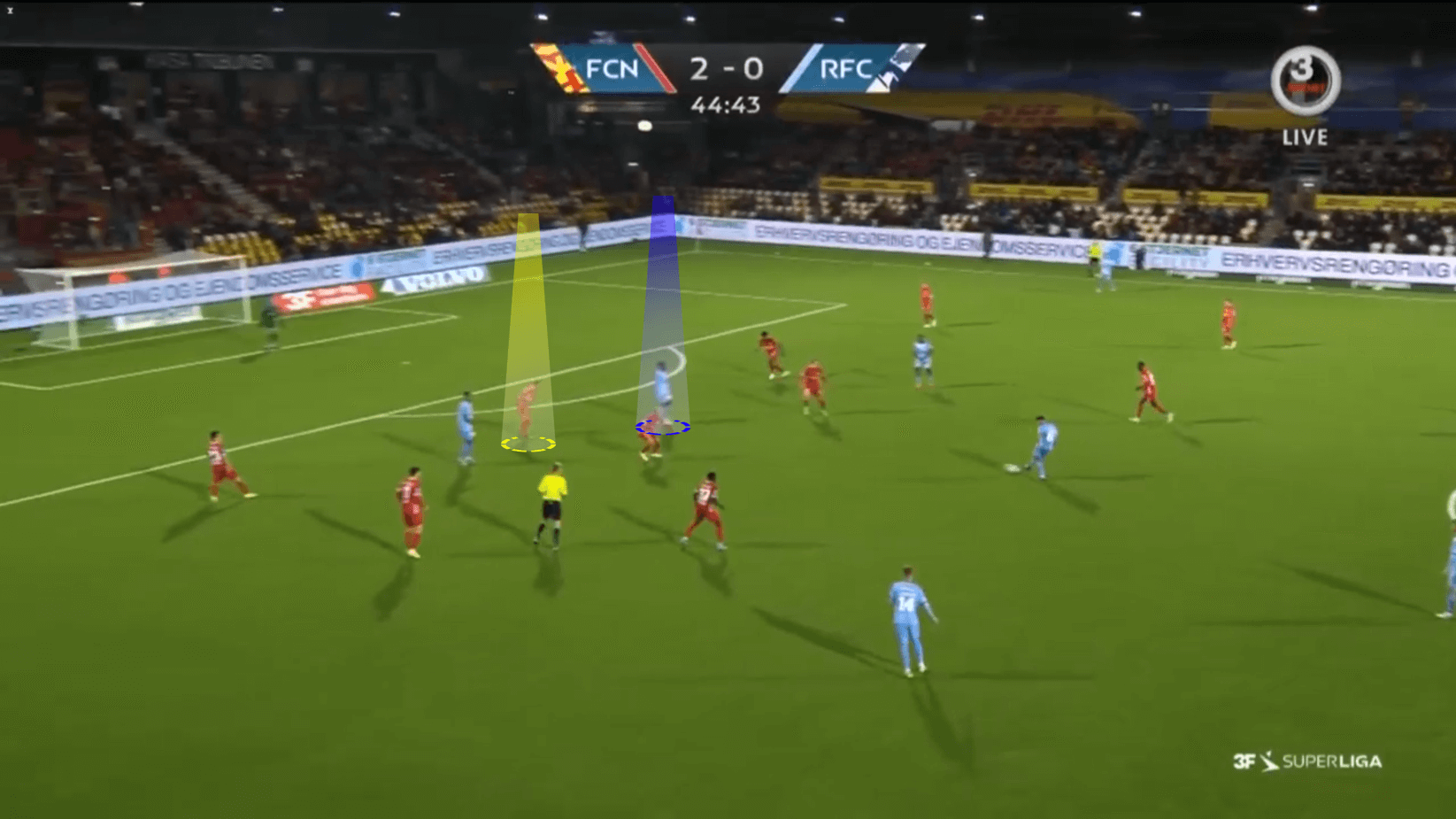
FC Nordsjaelland shows a very solid and smart defensive shape, where they can play in three of the known blocks, thanks to their versatility and adaptability to different kinds of situations. Their young and fresh legs can run all the game, but also be clever to know when they have to close down options and get into better positions to win the ball back in a more intelligent way.
Faster teams in possession have found their weaknesses in these transitions of high to mid-block, finding space behind the first line of pressure where they can run freely and create counterattacks. Even so, Nordsjaelland have committed and intense players that are capable of catching rivals in these kinds of runs, but it could be risky at times.
Frenetic attacks and ball-playing centre-backs
FC Nordsjaelland likes to be a dominant team in possession, but they do not want to stay a long time with the ball in their feet, although, this could change at several times when they need to attract teams closer to their goal, to then exploit the space behind. Pedersen’s team likes to get something out of the possession every time they get the ball, so they try to do it with multiple automatisms starting with their goalkeeper, centre-backs, full-backs or with simple line-breaking passes that find Mohamed Diomandé with time to turn and then run.
The first automatism in possession we are going to take a look at is in a very low part of the pitch, using the goalkeeper as a vital part to accumulate and attract, to break lines through the middle or to be able to connect with the full-backs, that can offer ball progression with their runs or long-passes to the strikers.
Below us we can see the typical first steps and movements of Nordsjaelland in the attacking phase, where their goalkeeper has played up to two-three passes with his centre-backs, attracting the pressure to then release the ball to the wide areas to the full-back. The next move is simple but effective. One of the attackers has to drop deeper in order to receive the long ball, in this case, the right-back is going to take.
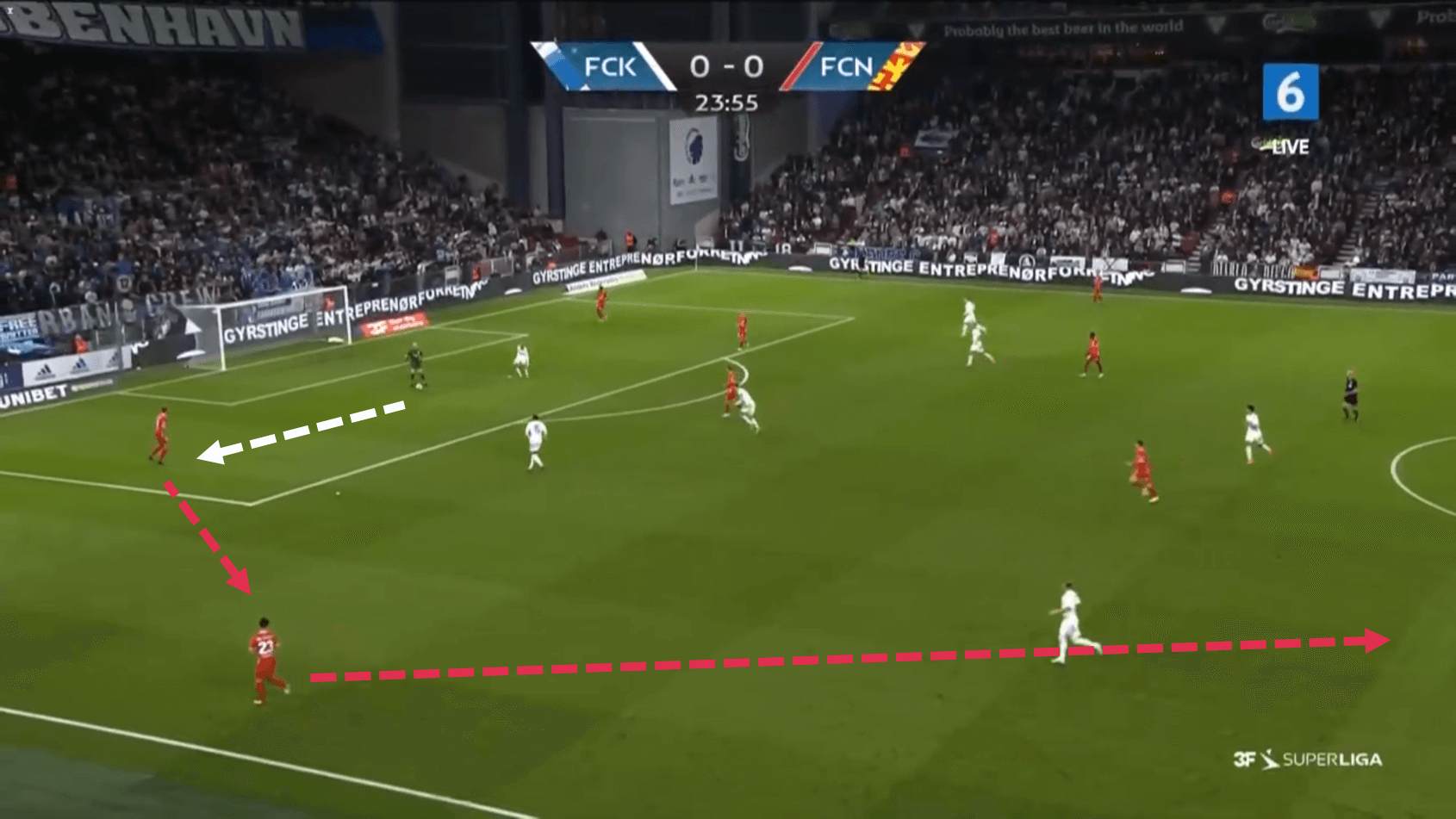
The goalkeeper shows his capacities too, and his good management of under-pressure situations. Against Kobenahvn again, we are going to see two types of passes he decides to execute to make his team progress in better conditions. It should be noted that the team wants to play the ball from the back without leaving the ground on many occasions, so Andreas Hansen does this wonderfully.
As we see below, there are two examples of how to break pressures with their goalkeeper. Being suffocated closely by the rival forward, they have attracted up to four or five players into their penalty box. This means a teammate, almost every time Diomandé can exploit this behind them, dropping deep and marking the pass for Hansen.
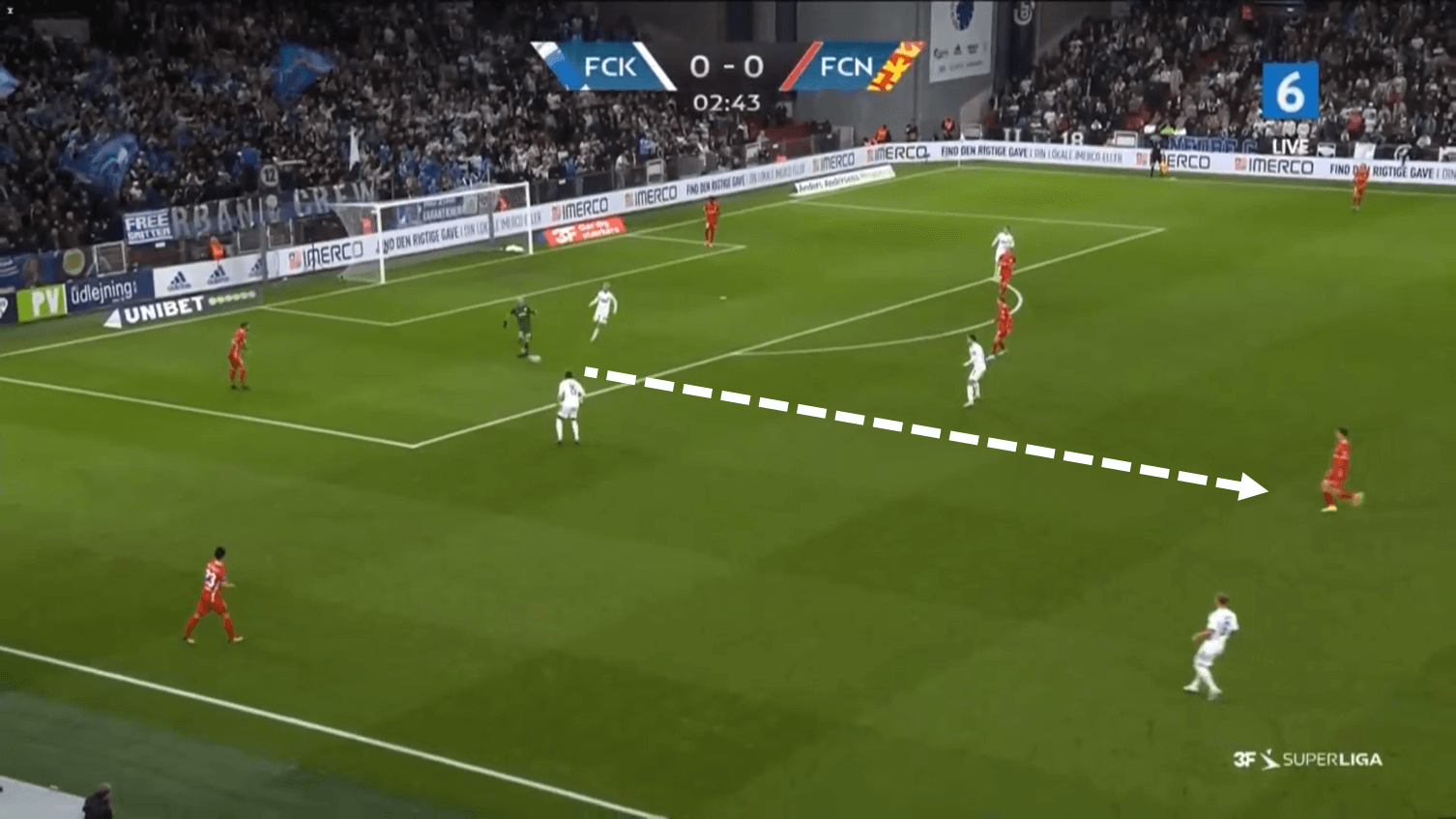
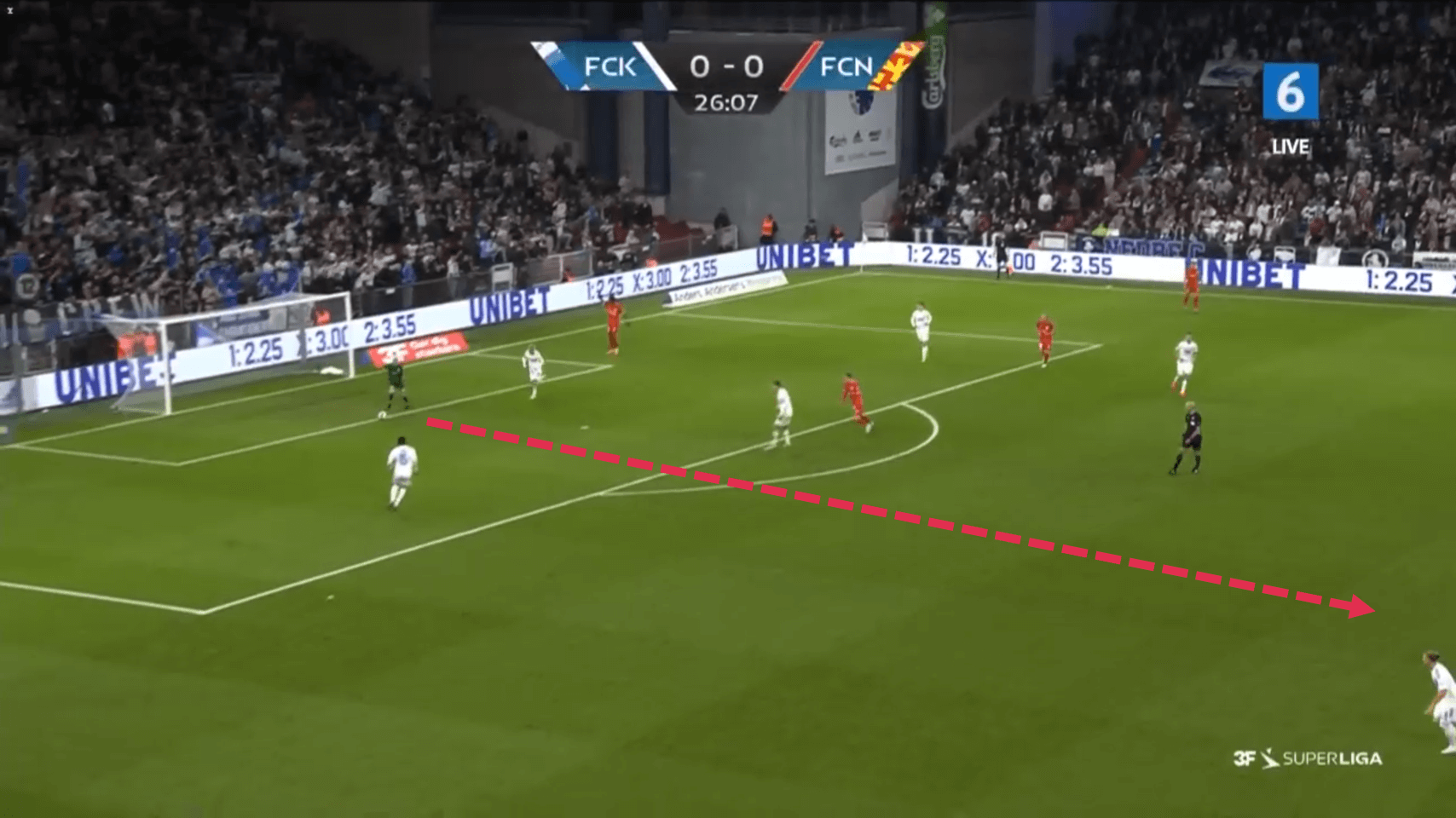
Another type of progression in Nordsjaelland’s build-up phase is what can centre-backs do with the ball. They’re usually allowed to make decisions and almost every time they break the lines of pressure through the middle, and the key player in this kind of movement is once again, Mohamed Diomandé, who likes to be functional and mobile, offering various passing options between several areas of the pitch.
As we can see, Adamo Nagalo, another exciting prospect of this team, is responsible to do this, because of his technical qualities and ball control to not only make progressive passes but also progressive runs dribbling and going forward.
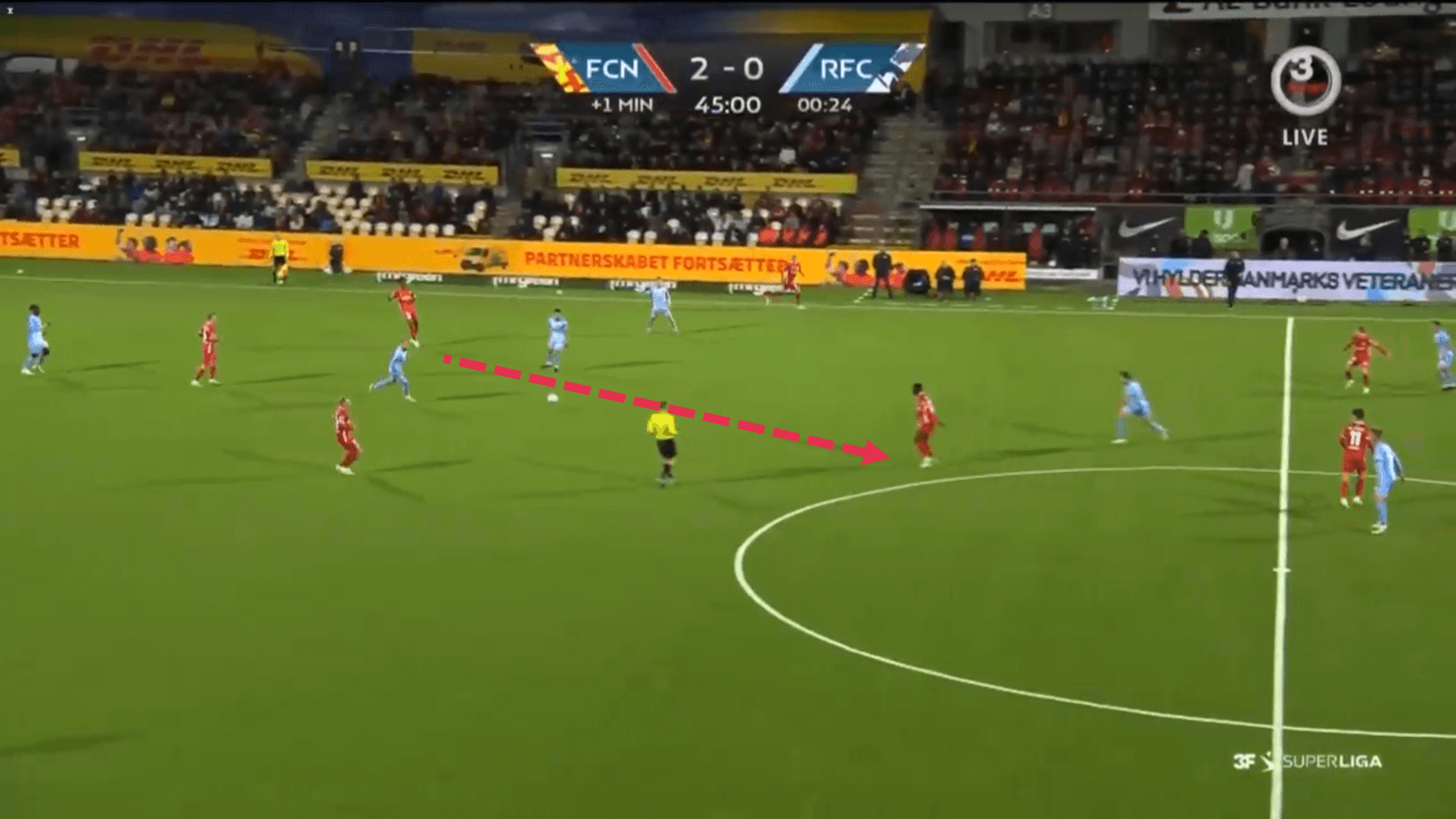
The search for the third man is another of the ways they look to break the pressure. They try to do this often playing it wide from the inside, making the full-back the third man on those occasions. But in this time we see the picture below, where Mads Bidstrup has recognized the situation, he releases the ball to the teammate in front of him, which is the centre-back, who then passes it to his ‘6’ and Bidstrup makes the run to the space available.
Centre-backs are a vital part of this team, not only for these moments but also for what they can improvise. They tend to look for wingers or full-backs in advanced positions with lanes to roam, skipping some steps of the build-up but trying to get into the penalty box and create some chances where matches keep being thick.
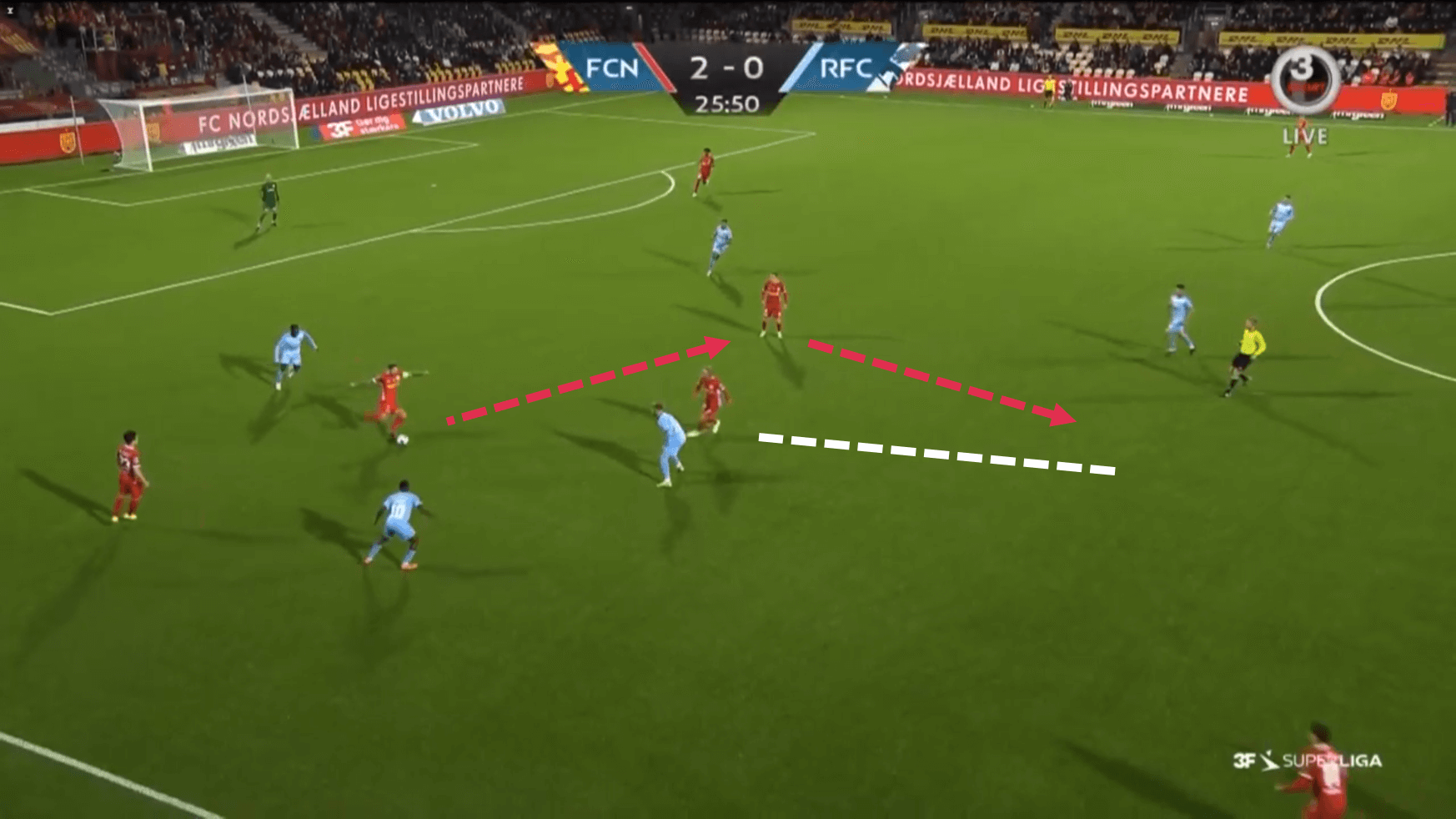
In the final third of the pitch, Nordsjaelland try to give plenty of freedom to their young attackers and midfielders but there are some principles attached to every attack: Overlapping full-backs, accumulating in one zone and then crossing it quickly to the weak side of the ball, with perfect timing runs in-behind from wingers or full-backs of the other side.
The two pictures below show exactly this automatic search to find the weak side of the ball. In the first one, we can see it is a closer attack to the rival penalty box, but the intention is the same. Diomandé has accumulated markers on the left side of the pitch, he has played a pass to right-winger Mads Hansen, which then sees that Oliver Villadsen, the right-back, recognising the free space to attack it. He goes there and crosses it immediately looking for Schjelderup on the weak side.
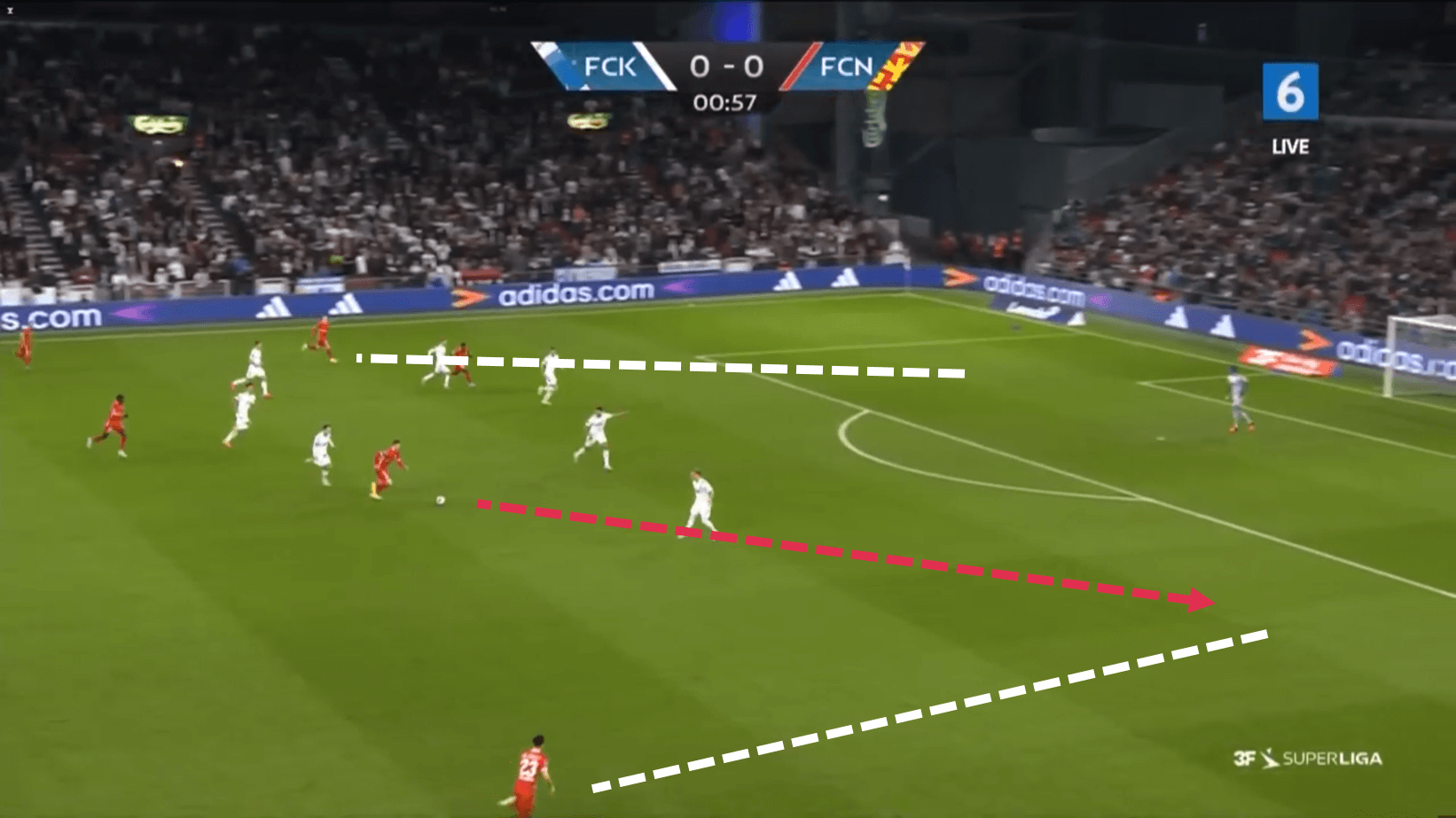
In another situation, Villadsen has performed very well in a one-two with his winger. He runs for the ball and another time sees Schjelderup making the run to the box. This time the ball is perfectly executed, and the 18-year-old left-winger scores the second goal of the team.
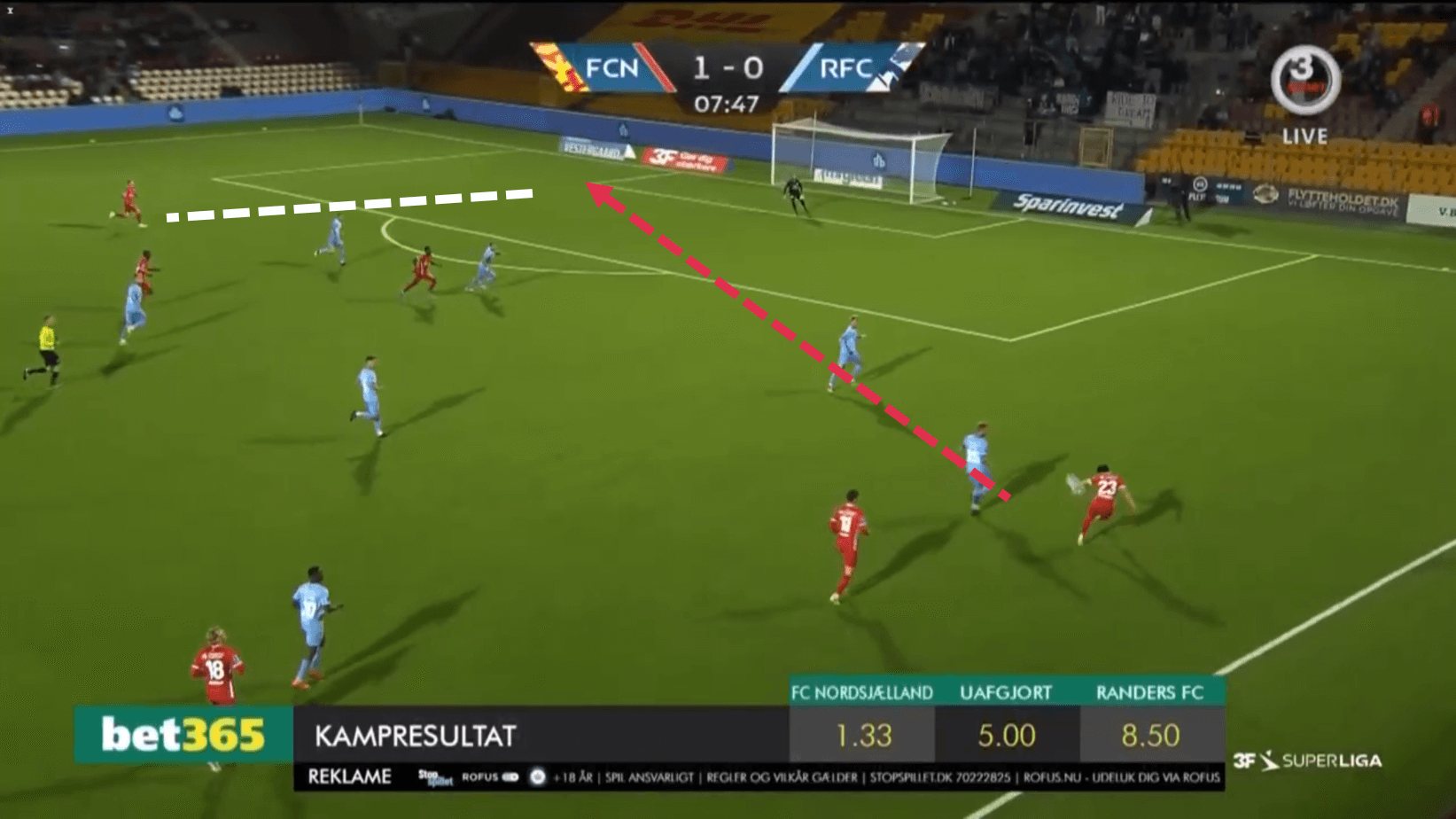
Transitions
Finally, but not less important, FC Nordsjaelland shows also an excellent display in their attacking transitions. They sometimes, usually when they’re winning, like to wait for the opponents a bit deeper, locking spaces for them to attack. So Schjelderup once again makes himself the target-man, as he is the most skilful and pacey player in the team, but also Ernest Nuamah enters this phase as he’s also quick and has the technical ability.
It’s very simple, whenever a transition situation is able to be activated, the pass is played without leaving the ground, to space or to the feet of Schjelderup, who’s very direct in his intentions, and always looks to attack the penalty box and find a shot.
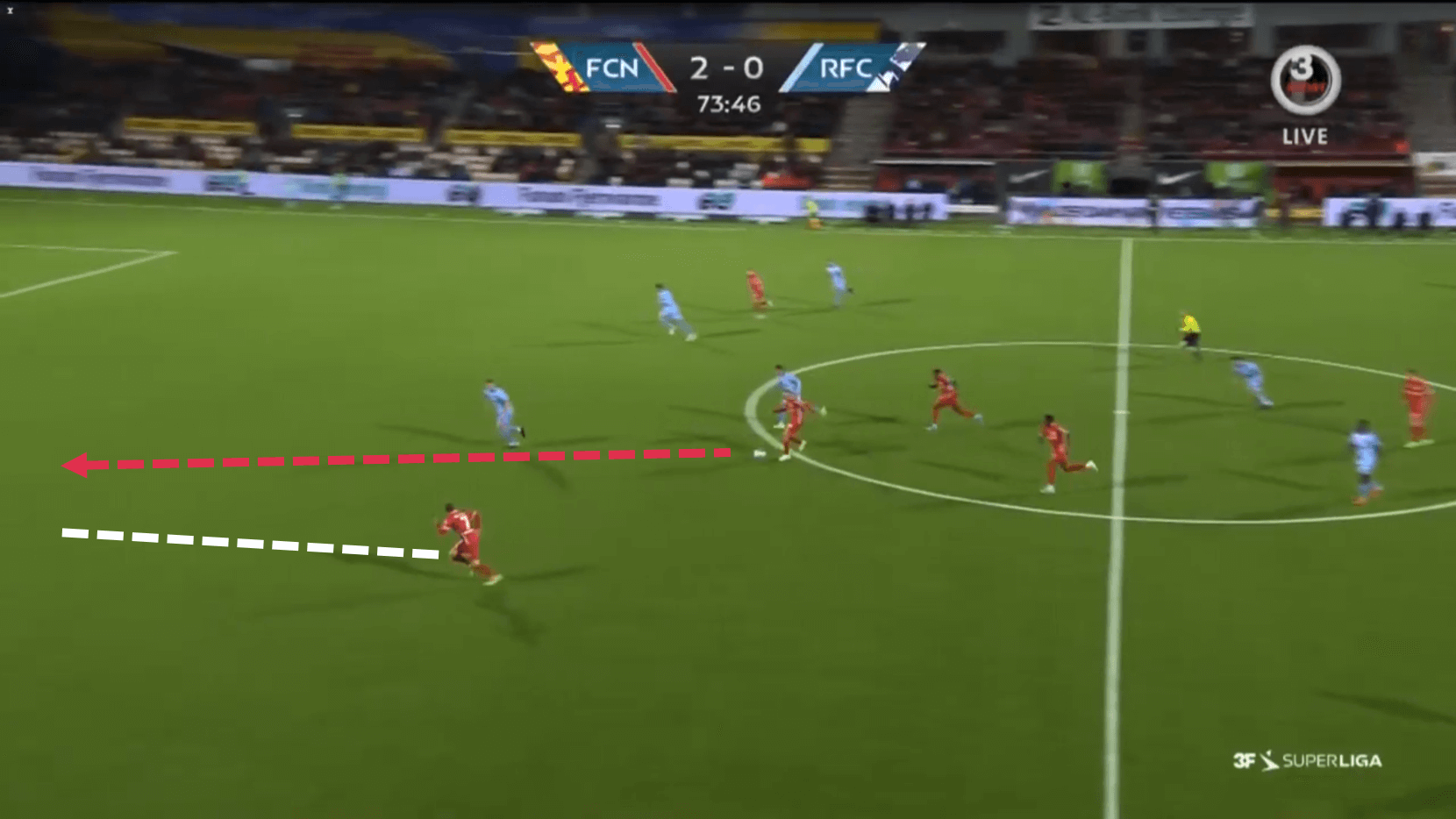
Normally, what you see above us is the type of transition that Nordsjaelland likes to execute. The conductor is always changing, it could be Diomandé, Jacob Christensen the ‘6’, Mads Bidstrup, or even Nuamah in a deeper role or the right-winger, whoever takes the ball and knows that the opponent team are at a numerical disadvantage, tries to locate Schjelderup, who’s always making the run behind the space full-backs create going into attack.
Conclusion
This analysis has shown us how Nordsjaelland likes to play football, in a very rapid and attacking style who tries to find every player on the pitch to contribute with at least one pass or smart off-the-ball movement, with very settled automatisms but also with the freedom and mobility for players to develop his individual qualities and create collective chaotic situations for an opponent to defend and then turn it to solid and mature defensive shapes.
Their motto ‘Right to Dream’ could turn into a realistic one in this chase of the Danish Superliga, with the youngest squad, ten years on from the club’s first and last title.






Comments